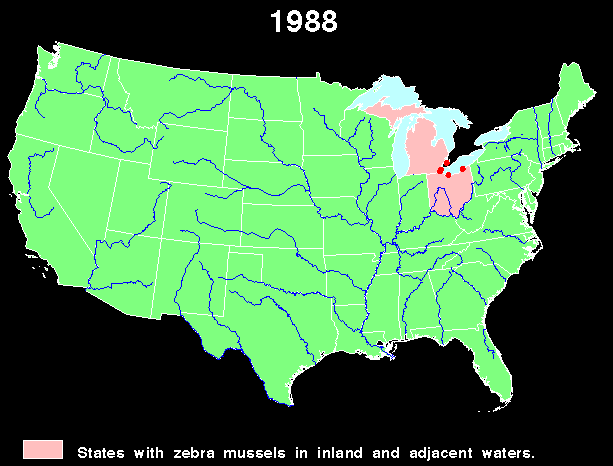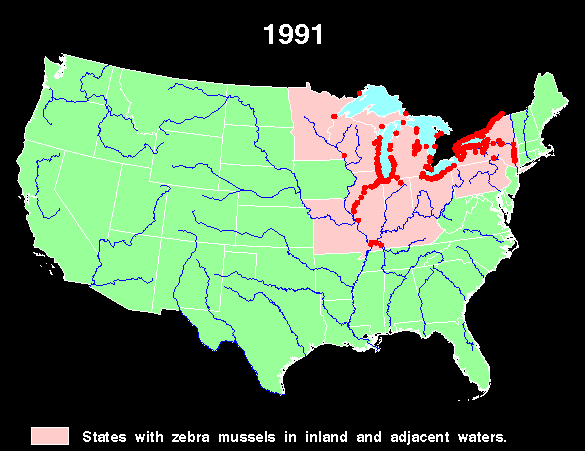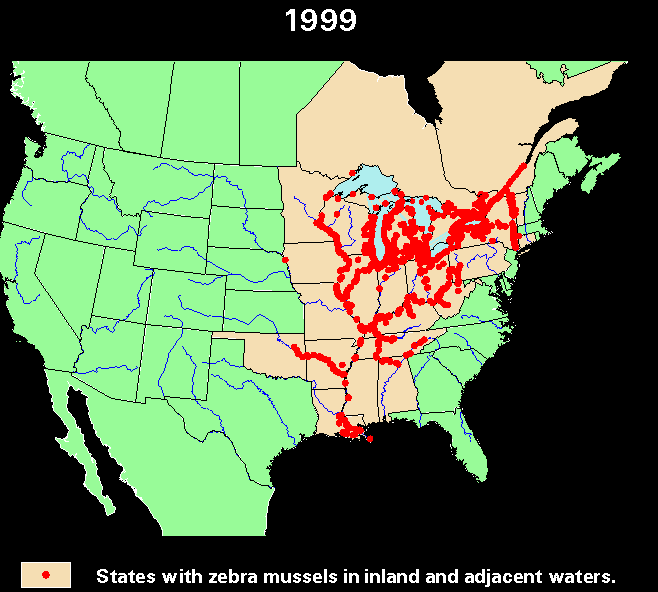The Zebra Mussel
Dreissena polymorpha, a European mussel, was first discovered
in North America in Lake St. Clair in June 1988. The first confirmed
sighting in the western basin of Lake Erie was in July 1988, and by 1991,
it was spreading rapidly throughout the Great Lakes basin and had reached
the Hudson River, upper Mississippi River, and the Susquehanna drainage basins.
It will probably soon achieve a wide distribution in North American lakes
and rivers and may be limited by soft water and temperatures in the extreme
northern and southern areas.
The zebra mussel arrived in the ballast water of transoceanic
ships from Europe. Ballast transport and fouling can also be credited with
the discontinuous spread of the mussel into major upper Great Lakes ports
in 1990. The mussel often occurs in very large numbers, and can exert large
and far-reaching impacts on freshwater ecosystems through biofouling and
filter-feeding. In Lake St. Clair, as the mussels reached high densities,
they were shown to detrimentally affect the native unionid clams in the lake
and to improve water clarity in the Detroit River. In 1992, genetic surveys
of Great Lakes zebra mussel populations have isolated a new introduced species
of Dreissena. The earliest verified collections of this zebra mussel
are from the Lake Ontario basin in 1991.

Source: Unknown
Zebra mussels get their name from the striped pattern
of their shells. However, the pattern has been seen to vary greatly to where
there are no stripes, only dark or light colored shells. Zebra mussels can
grow to a maximum length of about 50 mm (5-10 mm in the first year) and live
four to five years. They inhabit fresh water, usually at depths of two to
seven meters. Even though zebra mussels are freshwater animals, they have
recently been found living in brackish water with salinity levels of one
to two parts per thousand.
Zebra mussels travel using the tufts of hair like filaments called
byssal threads. They have as many as two hundred threads at one time
and secrete approximately twelve per day. These hair-like threads enable
the animal to travel great distances and attach to many mobile objects.
The byssal threads firmly bond to objects holding these animals in place.
This is part of the reason that these invasion species can cause far-reaching
destruction. Another reason that zebra mussels can travel great distances
is because they can survive out of water for about two weeks. This
enables them to be transported on boats or equipment from one body of water
to another. In the picture above, the zebra mussels have clogged a
water pipe causing great damage to the system and requiring costly repairs
(Lathlin, 2000). In some water facilities, the zebra mussels have been
known to reach layers about 1.5 meters thick. A mature female is capable
of producing up to one million eggs per season. Once the eggs are released
into the water, the male fertilizes them and within days, they turn into
free-swimming larvae called veligers. These veligers swim and travel
on water current for about three to four weeks. Only about one to three
percent survives and attach to a substrate where they mature into adults.
Zebra mussels are notorious for their biofouling capabilities
by colonizing water supply pipes of hydroelectric and nuclear power plants,
public water supply plants, and industrial facilities. They colonize pipes
constricting flow, therefore reducing the intake in heat exchangers, condensers,
fire fighting equipment, and air conditioning and cooling systems. Zebra
mussel densities were as high as 700,000 m2 at one power plant in Michigan
and the diameters of pipes have been reduced by two-thirds at water treatment
facilities. Although there is little information on zebra mussels affecting
irrigation, farms and golf courses could be likely candidates for infestations.
The animals were first found in Lake St. Clair in 1988. Since the
initial introduction of these species into North America, they have spread
to about eighteen states in the USA and two provinces in Canada
The maps below illustrate the rapid spread of the zebra mussel in the United
States:

Source: Unknown

Source: Unknown
One theory of many environmental scientists discusses the biology and ecology of organisms that are the predators of zebra mussels. The predators are primary birds and fish and they eat the zebra mussels. Other types of animals that reduce the population of zebra mussels are leeches, crabs, crayfish, and small rodents. Organisms that are capable of removing zebra mussels from their attached surface include sponges, amphipods, algae, bryozoans, hydrozoan coelenterates, and other bivalve species. Large amounts of the competitive species in Europe are not present in North America. There are no indications however that the competition is strong enough to eliminate the zebra mussel population. Large areas may be affected by the competitors but is not likely to have a large cumulative effect .
Zebra mussels are capable of filtering the water of the planktonic organisms
and this has caused a problem in the Great Lakes region. A large amount
of zebra mussels causes the amount of planktonic organisms to decrease rapidly.
The planktonic organisms are vital to the maintenance of the aquatic food
web.
Source: Unknown

Source: Unknown
Parts of this web page were developed by Lizzi Day, a GEO 333 student.
This material has been compiled for educational use only,
and may not be reproduced without permission. One copy may be printed for
personal use. Please contact Randall Schaetzl (soils@msu.edu)
for more information or permissions.